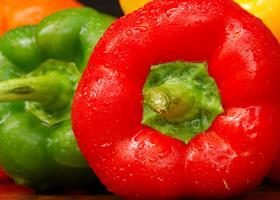
The 2015 UK salad season has been a mixed bag, with customer demand remaining relatively strong despite changeable weather and subsequent disease threats.
Pressure from the retail price war still lingers over the category, most notably on commoditised wholehead and baby leaf lettuce lines, as well as staple sub-categories including peppers and cucumbers. Peppers in particularly have faced a tough season, and heavy price deflation of up to 50p per kg was the primary driver of value decline in the wider salads category – down 5.2 per cent over the 52 weeks to 16 August [Kantar Worldpanel].
According to Kantar analysts, Tesco and Sainsbury’s are the top four retailers responsible for driving deflation in total salads, but while Sainsbury’s has seen volume growth of 7.9 per cent, Tesco has gained only 1.4 per cent.
Managing director of pepper grower Rainbow UK, Pleun van Malkenhorst, believes next year may see a more optimistic pepper season. “Consumption of sweet peppers in the UK remains strong, and we see growth in consumption time after time,” he explains. “The value is still difficult and the triple pack is still heavily discounted on the back of price deals made early last year. The fact the market price has been higher at the back end of this year could potentially mean the price of peppers goes up for next year.”
Cucumber suppliers are also struggling amid aggressive retail pricing, with discounters retailing as low as 22p during promotional weekends. “This is below the cost of growing and throws the future of UK and wider northern European production into question if the trend for continued reductions is not halted and reversed,” says Luke Hibberd, commercial director of Abbey View Produce. “In addition to the big four reacting to the discounters, those that do not have availability of UK product have been able to take advantage of the closed Russian borders and strong pound to fund their price decreases with European imports.”
On leafy salads, G’s marketing director Anthony Gardiner says strong price deflation has still been in evidence during the last 18 months, particularly on iceberg. “The wholehead category has become much more consolidated this year with the big lines getting bigger and some of the tail items dropping out as retailers have consolidated their ranges,” he explains.
Production hasn’t been any easier than marketing in recent months, and head of agronomy at salads supplier Freshtime, Mel Miles, says the 2015 UK season “will be remembered for a slow start following the cool spring weather, and the pest pressure during the heat of the summer.”
“Aphids were an issue during the warmer months and required constant vigilance. The drought conditions in southern Europe triggered supply issues across Europe, but we were insulated from this in the UK,” he adds. Miles says cool and wet September weather will slow growth rates and reduce availability of baby leaf, spinach and other short life-cycle crops, while cold nights, dull days and rain are likely to impact the remainder of the UK season.
Jackie Harris, chair of the British Leafy Salads Association, agrees salads growers have experienced a mixed-weather season. “We’ve had lots of rain, while the temperatures have been quite changeable. This can increase pest and disease pressure and make it quite difficult to manage the crop,” she says, adding that despite unpredictable conditions, “sales have been quite strong”.
For Harris, also technical manager at Evesham grower Valefresco, tomatoes have been one of the recent star performers. “Tomatoes have had a very positive season. We’ve been looking at smaller cherry tomatoes, with a focus on taste, and sales are definitely up as we’ve put more energy into it this year. We’re also seeing an increase from things like salad bowls,” she adds.
As a multi-tier category with constant NPD, marketing manager at Vitacress, Tony Reid, believes increased clarity and engagement with the consumer will bring the most benefits to salads. “Only 28 per cent of shoppers who pass the fixture buy anything; this is our biggest opportunity,” he says.
“The £1 bowl has broken new ground in offering a fairly complete salad at a round, low price point, making the category more accessible, and the more premium bowls have brought a new usage occasion and different demographic in. Ultimately the category growth depends on identifying and playing to each of these usage sets.”



